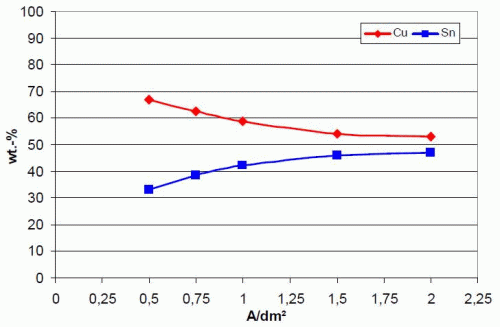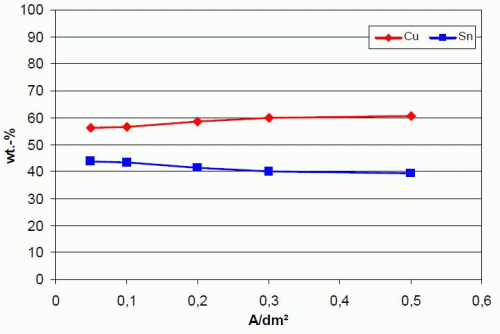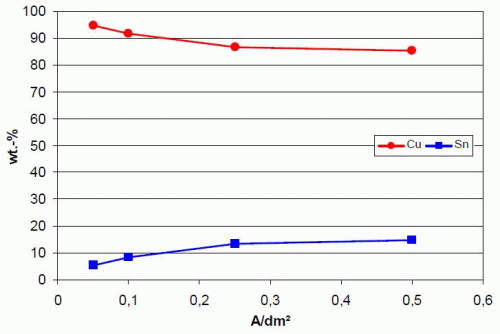Cyanide-Free Electroplating of Cu-Sn Alloys
This paper is a peer-reviewed and edited version of a presentation delivered at NASF SUR/FIN 2012 in Las Vegas, Nev., on June 13, 2012.
By Uwe Manz, Dr. Sascha Berger, Klaus Bronder, Klaus Leyendecker, Bernd Weyhmüller and Guenter Wirth Umicore Galvanotechnik GmbH
Editor's Note: This paper is a peer-reviewed and edited version of a presentation delivered at NASF SUR/FIN 2012 in Las Vegas, Nev., on June 13, 2012. A printable PDF version is available by clicking HERE.
Abstract
Copper-tin (Cu-Sn) layers are well known and frequently used to avoid the use of nickel in many decorative and some technical applications. Consequently the plating of bronze has been with us for a long time. At present industrial electroplating is still performed from solutions containing cyanide. There have been many attempts to substitute for cyanide, but so far only with minor success. The results have not been satisfying with regards to appearance, operating window, plating speed and other properties. Therefore the cyanide-free electroplating of bronze is still just a wish for many platers. However, the regulatory requirements regarding health and environment are increasing and the problem in getting a license for cyanide, especially in China, has become severe. Therefore the need for alternative cyanide-free electrolytes is high. This paper reviews some basic chemistry and some concepts as well as recent developments in the electroplating of Cu-Sn from cyanide-free electrolytes. The influence on properties such as alloy composition, appearance and operating window are highlighted.
Keywords: Copper-tin electroplating, bronze electroplating, cyanide substitutes, alloy electroplating
Introduction
Copper-tin (Cu-Sn) layers are well known and frequently used to avoid the use of nickel in many decorative and some technical applications. At present industrial electroplating is still performed from solutions containing cyanide. There have been many attempts to substitute for cyanide, but so far only with minor success. The results have not been satisfying with regards to appearance, operating window, plating speed and other properties. Therefore the cyanide-free electroplating of bronze is still just a wish for many platers. However, the regulatory requirements regarding health and environment are increasing and the need for alternative cyanide-free electrolytes is high. This paper reviews some basic chemistry and some concepts as well as recent developments in the electroplating of Cu-Sn from cyanide-free electrolytes.
Properties of Cu-Sn Alloys
Copper-tin alloys, especially bronzes, are one of the first metallic materials used by mankind. The excellent properties of bronzes, such as:
- Good resistance to outdoor exposure,
- White and yellow (gold) color with a bright appearance,
- Hard and polishable,
- Diamagnetic properties for high frequency connectors, and
- Good wear resistance
have led to the development of electroplating solutions. A further advantage is the fact, that Cu-Sn alloys do not cause allergies and can be substituted nickel in some applications.
Electroplating History
The electroplating of copper-tin alloys is more than 170 years old, with the first activities reported around 1842. The constituents used in the first-mentioned electrolytes were cyanide complexed copper and tin in form of stannate. These components are still used in modern cyanide-based electroplating solutions.1
Cyanide-based Electrolytes
In the literature two types of electrolytes are described for the deposition of Cu-Sn alloys, one with 10-20 wt% of tin with a gold-yellow color and another with 35-50 wt% of tin for coatings with a shiny white appearance (speculum, mirror-alloy).
The baths containing cyanides (and stannates) are state-of-the-art and offer the following properties:
- Wide range of applicable current density
- Good throwing power (similar to cyanide copper)
- Compact, shiny/bright coatings
- Good color distribution (constant color)
- Wide range of alloy composition possible (bronzes with white & yellow colors)
- Applicable for barrel, rack and high speed plating
- Insoluble anodes (soluble anodes possible)
- Current efficiency (75 %)
- Stable electrolyte
- Long but limited lifetime (formation of carbonates)
- Sensitive against nickel impurities (decreasing efficiency)
- Cyanide detoxification required (wastewater)
Some compositions contain heavy metals, e.g., lead as part of the brightener system, hence the coatings also contain lead. Nonetheless, more recent compositions have been developed which come with a lead-free additive system.
The basic composition and operating conditions of the two typical CN-based electrolytes are given in Table 1. The alloy composition can be controlled by the varying the concentrations of copper, tin, KCN and/or KOH.
Table 1 - Basic composition and operating conditions for CN-based white and yellow bronze electrolytes.
|
|
White Bronze |
Yellow Bronze |
|
Composition |
53-57% Cu; 47-43% of Sn |
80-90% Cu; 10-20% of Sn |
|
Cu as potassium copper(I) cyanide |
2 g/L |
15 g/L |
|
Sn as sodium stannate |
6 g/L |
17 g/L |
|
Potassium cyanide (free) |
15 g/L |
35 g/L |
|
Potassium hydroxide |
6 g/L |
25 g/L |
|
Brightener system |
Lead |
Organic |
|
Anodes |
Insoluble |
Insoluble |
|
Operating temperature |
40-50°C |
50-60°C |
|
Cathodic current density |
0.5-1.5 A/dm2 |
2-4 A/dm2 |
|
Plating speed |
0.14 µm/min at 1 A/dm2) |
0.6 µm/min at 3 A/dm2) |
Cyanide is a strong complexing agent. For this reason it is often used in the electroplating industry. In the case of copper-tin alloys, the use of cyanide allows and controls the simultaneous deposition to form a compact alloy with excellent properties. In addition, the anodic degradation products are not immediately problematic for the function of the electrolyte.
The major drawback of cyanides is the strong and rapid-acting toxicity. For this reason cyanides are more and more restricted, although safe handling procedures exist and their detoxification in wastewater can be controlled quite readily and effectively.
The restriction on cyanides applies to the import, storage, transportation and handling of dangerous goods. For all these activities a license is required and special requirements must be followed. This situation has become worse in recent years. In China, it is very difficult and time consuming to obtain a cyanide license. In addition, the upper limits apply to the total amount of cyanides in a given company in its entirety. This is clearly a driver for the continued development of cyanide-free electrolytes.
Cyanide-free Electrolytes
The electroplating of cyanide-free bronzes is not new. In his book on alloy electroplating, Brenner gave an overview on cyanide-free electroplating.1
The role of the cyanide is to stabilize (bind / chelate) the copper in the solution and allow the simultaneous, fine grained codeposition with tin. Copper forms the complex [Cu(CN)3]-2 with cyanide in solution. This complex exhibits a good solubility and is relatively stable. In electrolytes with soluble anodes, free cyanide ensures good anode corrosion.
All these functions should be provided by any potential substitute. Work has been done on several possible basic cyanide-free electrolytes. Some sample processes are listed below.
Alkaline electrolytes:
Tartrate (C4H4O6-2)
Pyrophosphate (P2O7-4)
Phosphonates (R-PO3-2)
Neutral electrolyte:
Tripolyphosphate, P3O10-5 (Kudra, et al2)
Acid electrolytes:
Oxalic acid [(COOH)2]
Fluoboric acid (HBF4)
Sulfuric acid (H2SO4)
Methanesulfonic acid (CH3SO3H)
Unfortunately, most of them suffer from one or more drawbacks, compared to electrolytes operated with cyanide. Such shortcomings include:
- Instability of the electrolyte
- Oxidation of electrolyte components (Sn(II), tartrate, additives, etc.)
- Breakdown of electrolyte components
- Decreasing current efficiency
- Quality of the deposits not acceptable
- Color not white enough (white bronze)
- Non-uniform color/alloy composition
- Increased copper codeposition in low current density area, leading to dark reddish deposits
- Tarnishing of the deposits within a short period of time
- Hazy, streaky, rough, non-compact deposits at makeup or after a short time thereafter
- Limited maximum thickness with good appearance of the deposits
- Narrow applicable current density range
- Slow plating speed
- Corrosivity of the electrolyte
- Wastewater treatment issues
Electrolytes based on pyrophosphate, phosphonates and methanesulfonic acid have the least disadvantages and the highest potential to become accepted by the industry.
Other Considerations
Oxidation or breakdown of electrolyte components in the tartrate electrolyte
In the tartrate electrolyte, the tartrate ion decomposes at the anode. That leads to the formation of copper-containing precipitates.1
Oxidation of tin
In all electrolytes the oxidation of divalent tin [Sn(II)] to tetravalent tin [Sn(IV)] can take place at the anode, but the main reaction occurs with atmospheric oxygen.3 The resulting stannate(IV) is stable and accumulates in the electrolyte. In acid solutions, it forms hydroxides that precipitate by splitting off water and thus forming species like SnO2•xH2O and finally SnO2 sludge. This precipitate is often finely dispersed, or in a colloidal form and cannot be simply filtered off.
Several substances ("stabilizers"), described as antioxidants, avoid or slow down the oxidation reaction. Examples are pyrocatecol, hydroquinone, resorcinol, phloroglucinol, pyrogallol, 3-amino phenol, hydroquinone sulfuric acid ester, cresolsulfonic acid.3-7
Alloy distribution and color uniformity
Non-uniform color is mainly caused by unfavorable alloy distribution as a function of the current density. If the alloy composition differs too much between high and low current density, then complex shaped parts, or parts plated in barrels will exhibit differing colors.
A pyrophosphate electrolyte8 deposits markedly more copper in the low current density area, as shown in Fig. 1. Therefore it is not the best choice for barrel plating, but applicable for rack plating.
In a basic phosphonate electrolyte, the change in copper concentration as a function of the current density is quite strong and at low current densities (Fig. 2), the deposits show a reddish / brownish color, while it is white at "normal" operating current densities. The addition of a selective chelating agent for copper (sulfur-containing additive) changes the situation completely (Fig. 3). With the addition of the additive to the phosphonate electrolyte, the alloy distribution is much more homogeneous and the electrolyte is now suitable for barrel plating without color uniformity problems.

Figure 1 - Cu-Sn pyrophosphate electrolyte: alloy composition as a function of current density.

Figure 2 - Cu-Sn phosphonate electrolyte: alloy composition as a function of current density.

Figure 3 - Cu-Sn phophonate electrolyte with additive: alloy composition as a function of current density.
Electrolytes based on methanesulfonic acid (MSA) show a different behavior. The basic electrolyte without additives shows a high copper codeposition and the color of the deposits is red to yellow (Fig. 4). The addition of chelating additives that mainly affect copper deposition, depresses the codeposition of copper. White coatings with a relatively constant alloy composition can be deposited (Fig. 5). With this improved electrolyte, plating at low current densities does not result in a dramatic increase of the codeposition of copper with red deposits. Appropriate chelating agents are, e.g., gluconic acid or sulfur-containing additives such as thioethers.4

Figure 4 - Cu-Sn MSA electrolyte without additive: alloy composition as a function of current density.

Figure 5 - Cu-Sn MSA electrolyte with additive: alloy composition as a function of current density.
Tarnishing of deposits
White bronze with approximately 40-45 wt% of tin (60-55 wt% of copper) is usually resistant to tarnishing. If the tin concentration is too low, then the deposits tend to become tarnished with a brownish appearance.9 In the experience of the authors, the limit is also related to the type of electrolyte used. The deposits from the MSA electrolyte mentioned above are tarnish resistant. This means that below 64-65 wt% of copper or higher than 35-36 wt% of tin, no tarnishing is observed.
Electrolyte life
Electrolyte life is a major issue for a production-proven process. Here the MSA-based and pyrophosphate electrolytes show the best performance. The phosphonate-based electrolyte shows a very good performance at makeup, but within a short period of time (1-2 A-hr/L), the results worsen with respect to appearance and efficiency. An operation with membrane-separated anodes does not improve the situation, so the effect is not caused by anode-related processes. The best performance is shown by the MSA-electrolyte. Up to now no limit has been observed. The stannate(IV) formed does not affect the deposition even in large concentrations.
Anodes
Anodes are important. The use of insoluble anodes (e.g., graphite or mixed metal oxide anodes) leads to generally higher operating potentials. This can lead to problems with oxidation of sensitive organics. Soluble anodes are preferable, but often problems also arise. When using separate copper or tin anodes, copper often precipitates on the tin anodes or vice versa, depending on the relative concentrations of copper and tin in the electrolyte being considered. It is also complex to split and balance the current flow between different anodes. Alloy anodes are preferred in this case, but here issues with the availability, stability and solubility may arise. If the electrolyte is not designed to be used with soluble anodes, then problems with passivation can also happen.
Overview
Table 2 gives some of the typical compositions and properties of the coatings and electrolytes based on phosphonate, pyrophosphate and methanesulfonic acid.
Table 2 - Typical compositions, operating conditions and properties of the coatings and electrolytes based on phosphonate, pyrophosphate and methanesulfonic acid.
|
|
Phosphonate |
Pyrophosphate |
Methanesulfonic acid (MSA) |
|
Electrolyte composition |
|||
|
Copper |
0.5 g/L |
3.0 g/L |
2.0 g/L |
|
Tin |
5.0 g/L |
5.0 g/L |
1.0 g/L |
|
Stabilizer |
10 g/L |
20 g/L |
20 g/L |
|
Potassium Pyrophosphate |
--- |
200 g/L |
--- |
|
Phosphonate |
100 g/L |
--- |
--- |
|
Methanesulfonic acid |
--- |
--- |
200 g/L |
|
Organic additives |
10 mL/L |
70 mL/L |
15 mL/L |
|
Operating conditions |
|||
|
Temperature, °C |
50 |
40 |
35 |
|
pH |
10 |
8 |
≤1 |
|
Current density, A/dm2 |
0.05-0.50 |
0.80 |
0.1-0.5 |
|
Plating speed, µm/min |
0.03 at 0.1 A/dm2 |
0.22 at 0.75 A/dm2 |
0.08 at 0.3 A/dm2 |
|
Throwing power (Haring-Blum cell; Fields equation) |
55% |
N.A. |
72% |
|
Barrel plating |
Good |
Bad |
Excellent |
|
Rack plating |
Acceptable |
Good |
Very good |
|
Process window |
Acceptable |
Good |
Very good |
|
Deposit properties |
|||
|
Alloy composition, wt% |
63% Cu/37% Sn |
55% Cu/45% Sn |
63% Cu/37% Sn |
|
Max. coating thickness, µm |
1.0-2.0 |
0.5 |
5.0 |
|
Hardness HV25 (cross-section) |
450 |
500 |
550-600 |
|
Appearance |
Bright |
Bright |
Bright |
|
Deposit color |
White |
White |
White |
|
Color values, CIE-L*/a*/b* |
80/0/9/7.0 |
83/0.5/7.8 |
84/0.4/5.3 |
|
Tarnish resistance |
Good |
Acceptable |
Very good |
|
Electrolyte life |
Short |
Good |
Very good |
Summary and Conclusion
The development of cyanide-free Cu-Sn electrolytes is still in progress and there is still need for further improvement. Many details and variables must be observed when shifting to a cyanide-free Cu-Sn plating solution. Each of the electrolytes has its own characteristics. With the actual development of new MSA-based electrolytes, the door to an industrial accepted process has been opened.
References
1. A. Brenner, “Electrodeposition of Copper-Tin Alloys,” in Electrodeposition of Alloys, Academic Press, New York and London, 1963; p. 497.
2. O.K. Kudra, et al., “Issledovanie polyarizacii pri elektroosajdenii splava med-olova iz tripolifosfatnih elektrolitov,” Ukrainskii Khimicheskii Zhurnal, 38, 875 (1972).
3. M. Jordan, Die galvanische Abscheidung von Zinn und Zinnlegierungen, Leuze Verlag, Saulgau/Württemberg, 1993; p. 62f.
4. K. Bronder, et al., Umicore Galvanotechnik GmBH, “Copper-tin electrolyte and method for depositing bronze layers,” European Patent Office, Patent No. EP1961840 (2008).
5. M. Dietterle, M. Jordan and G. Strube, Dr.Ing. Max Schlötter GmbH & Co., “Electrolyte and method for depositing tin-copper alloy layers,” European Patent Office, Patent No. EP1325175 (2003).
6. Q. Chen and A. Egli, Rohm and Haas Electronic Materials LLC, “Electroplating Bronze,” European Patent Office, Patent No. EP 2071057 (2009).
7. J. Dr. Heyer, et al., Enthone Inc., “Process for galvanic deposition of bronze,” European Patent Office, Patent No. EP 1408141 (2004).
8. S. Berger, et al., Umicore Galvanotechnik GmBH, “Modified copper-tin electrolyte and method of depositing bronze layers,” European Patent Office, Patent No. EP 2116634 (2010).
9. H.W. Dettner and J. Elze, Handbuch der Galvanotechnik - Band II Verfahren für die galvanische und stromlose Metallabscheidung, Carl Hanser Verlag, München, 1966; p. 494.
Related Content
Highlights from SUR/FIN 2023
Products Finishing offers a recap of some of the topics that were top of mind at the SUR/FIN 2023 finishing industry trade show.
Read MoreConnect, Collaborate and Contribute to the Industry at SUR/FIN 2024
Atlanta, Georgia, is the home to this year’s NASF SUR/FIN conference and trade show.
Read MoreTin-Zinc Alloy Electroplating and Its Corrosion Behavior
An NASF/AESF Foundation Research Program Retrospective
Read MoreTake Full Advantage of Industry Events
As travel plans ramp up for the year, what industry events will you attend? Products Finishing offers a quick look at some of the upcoming opportunities for 2024.
Read MoreRead Next
Delivering Increased Benefits to Greenhouse Films
Baystar's Borstar technology is helping customers deliver better, more reliable production methods to greenhouse agriculture.
Read MoreEpisode 45: An Interview with Chandler Mancuso, MacDermid Envio Solutions
Chandler Mancuso, technical director with MacDermid Envio discusses updating your wastewater treatment system and implementing materials recycling solutions to increase efficiencies, control costs and reduce environmental impact.
Read MoreEducation Bringing Cleaning to Machining
Debuting new speakers and cleaning technology content during this half-day workshop co-located with IMTS 2024.
Read More















.jpg;maxWidth=300;quality=90)








